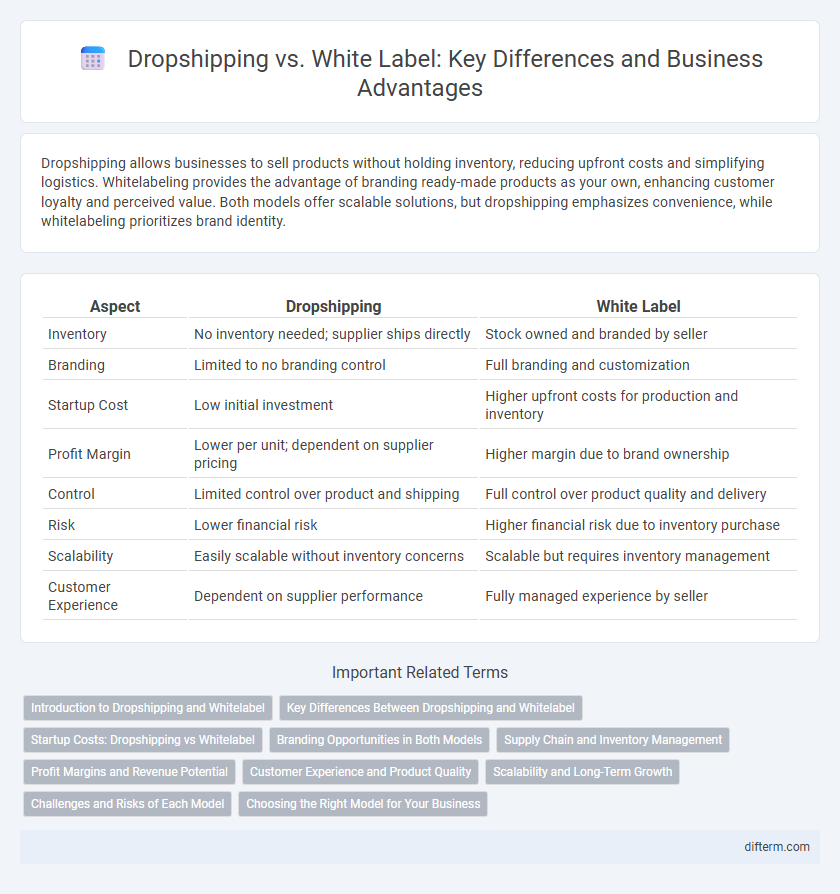Dropshipping allows businesses to sell products without holding inventory, reducing upfront costs and simplifying logistics. Whitelabeling provides the advantage of branding ready-made products as your own, enhancing customer loyalty and perceived value. Both models offer scalable solutions, but dropshipping emphasizes convenience, while whitelabeling prioritizes brand identity.
Table of Comparison
| Aspect | Dropshipping | White Label |
|---|---|---|
| Inventory | No inventory needed; supplier ships directly | Stock owned and branded by seller |
| Branding | Limited to no branding control | Full branding and customization |
| Startup Cost | Low initial investment | Higher upfront costs for production and inventory |
| Profit Margin | Lower per unit; dependent on supplier pricing | Higher margin due to brand ownership |
| Control | Limited control over product and shipping | Full control over product quality and delivery |
| Risk | Lower financial risk | Higher financial risk due to inventory purchase |
| Scalability | Easily scalable without inventory concerns | Scalable but requires inventory management |
| Customer Experience | Dependent on supplier performance | Fully managed experience by seller |
Introduction to Dropshipping and Whitelabel
Dropshipping is a retail fulfillment method where the seller does not keep products in stock but transfers customer orders directly to suppliers who ship items on their behalf. Whitelabel involves rebranding existing products produced by a manufacturer, allowing businesses to sell under their own brand without developing products from scratch. Both strategies minimize inventory risks but differ in brand control and supply chain management.
Key Differences Between Dropshipping and Whitelabel
Dropshipping involves selling products directly from suppliers without holding inventory, whereas whitelabel requires purchasing products in bulk and branding them under your own label. Dropshipping offers lower upfront costs and less risk, while whitelabel provides greater control over product quality and brand identity. The key differences lie in inventory management, profit margins, and brand differentiation strategies.
Startup Costs: Dropshipping vs Whitelabel
Dropshipping startup costs are significantly lower, typically ranging from $100 to $500, as it requires no inventory purchase or warehousing, making it ideal for entrepreneurs with limited capital. In contrast, white-label businesses demand higher initial investment, often between $2,000 and $10,000, due to expenses in product development, packaging, branding, and bulk inventory purchasing. Evaluating budget constraints and risk tolerance is essential when choosing between dropshipping's low upfront costs and white-label's higher investment with greater control over branding.
Branding Opportunities in Both Models
Dropshipping offers limited branding opportunities as products are sold under the supplier's brand, restricting customization and customer experience control. Whitelabeling allows businesses to create and sell products under their own brand name, enhancing brand identity and customer loyalty through personalized packaging and marketing. Choosing whitelabel over dropshipping significantly strengthens long-term brand recognition and competitive advantage in the market.
Supply Chain and Inventory Management
Dropshipping relies on third-party suppliers to handle inventory and shipping directly to customers, reducing upfront inventory costs and minimizing supply chain risks. Whitelabeling requires the business to purchase, store, and manage inventory, offering greater control over product quality and supply chain coordination. Efficient inventory management in whitelabel involves forecasting demand and maintaining stock levels, while dropshipping depends heavily on supplier reliability and real-time stock availability.
Profit Margins and Revenue Potential
Dropshipping offers lower profit margins due to higher product costs and reliance on third-party suppliers, but it requires less upfront investment, enabling quicker scaling and revenue generation. Whitelabeling, with higher profit margins from customized products and brand control, demands significant initial investment in inventory and marketing yet allows greater revenue potential through brand loyalty and premium pricing. Selecting between dropshipping and whitelabel hinges on prioritizing immediate cash flow versus long-term profitability through brand equity.
Customer Experience and Product Quality
Dropshipping often sacrifices product quality and customer experience due to reliance on third-party suppliers with limited control over inventory and shipping times. Whitelabel products offer superior consistency and branding opportunities, enhancing customer trust and satisfaction through direct oversight of manufacturing and quality assurance. Businesses prioritizing long-term growth benefit from whitelabel strategies by delivering reliable products and personalized service that fosters stronger customer loyalty.
Scalability and Long-Term Growth
Dropshipping offers low upfront investment and flexible inventory management, making it easier to start quickly but often limits scalability due to thin profit margins and supplier dependency. Whitelabeling enables greater control over product quality and branding, which fosters stronger customer loyalty and higher profit margins essential for sustainable long-term growth. Businesses seeking scalable growth should prioritize whitelabel models to build unique brand identity and maintain consistent product supply.
Challenges and Risks of Each Model
Dropshipping faces challenges such as inventory reliance on third-party suppliers, leading to potential stock shortages and delayed shipping times that can harm customer satisfaction. Whitelabel involves risks including higher upfront costs for product development and branding, alongside the responsibility of managing quality control and inventory logistics directly. Both models require careful supplier vetting to mitigate risks related to product quality and fulfillment consistency, impacting brand reputation and profitability.
Choosing the Right Model for Your Business
Choosing between dropshipping and whitelabel models depends on your business goals, inventory control, and brand identity priorities. Dropshipping offers low upfront investment and flexible product testing, while whitelabeling provides stronger brand recognition and higher profit margins by customizing products under your label. Analyzing factors like supply chain management, customer experience, and scalability will help determine the optimal model for sustainable growth.
Dropshipping vs Whitelabel Infographic

 difterm.com
difterm.com